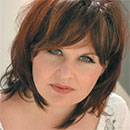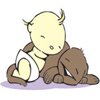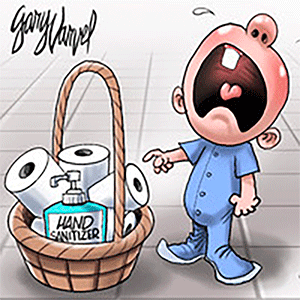Why 'Didion & Babitz' author warns readers: Don't be a baby
Published in Books News
In “Didion & Babitz,” author Lili Anolik opens with some advice: “Reader, Don’t be a baby.”
It’s an apt warning for readers who might consider themselves Joan Didion and/or Eve Babitz aficionados. While their most ardent fans — Sixties counterculture devotees and literary It-girl wannabes (of which I am both) — know the lore, Anolik, reader, knows much more.
What was really going on behind Didion’s glamorous dark shades and detached cool customer mien? Why did it seem as though Babitz went into hiding after a famously photographed nude game of chess with Marcel Duchamp and only a handful of books? “Didion & Babitz,” a dual biography of the two women’s enmeshed personal lives and careers, drops the veil on the prolific L.A. chroniclers. What you see in these pages — much more than Didion, effortlessly chic with her ever-burning cigarette, and Babitz, fueled by drugs and an untamed libido — you will never unsee.
“I didn’t mean to write this book,” Anolik tells me over a recent Zoom call. The author had published the acclaimed “Hollywood’s Eve” in 2019, a few years before she became privy to a box of letters buried in the closet of Babitz’s squalid apartment. Babitz’s sister Mirandi had Facetimed Anolik and told her about the boxes filled with “Letters. Lots of letters — to Eve, from Eve . . .” It was January 2022, the day after the author’s memorial, before Anolik got her hands on the stash, and the first thing she pulled from the pile was a scathing missive (penned but unsent) to Didion.
“It so fundamentally changed my understanding of Eve that I knew I was going to have to revise [‘Hollywood’s Eve’] to do right by her,” Anolik says. “I thought I could do it pretty quickly, write an introduction, shove in a few letters and move on. But it was too profound. Then I realized, as I was doing this, that I was writing a shadow book on Joan and that the women could best be understood in relation to one another.”
The letter, which rants on for a page and a half, conjures up an image of Babitz, shrouded in cigarette smoke and keyed up on rage and cocaine, hammering away at her typewriter, “Could you write what you write if you weren’t so tiny, Joan? Would you be allowed to if you weren’t physically so unthreatening?” Whether that’s how it happened or just a fantasy evoked by Anolik’s vivid reporting, it’s only a snapshot of the sprawling relationship between the two.
Anolik calls it a “lovers’ quarrel.”
Early on in “Didion & Babitz,” Anolik makes it clear she’s partial toward Babitz, but when I ask her whether she’s a “Joan or an Eve” (this week, the question inspired an official quiz in Vogue), she says she’s much closer to a Joan. “I’m really anally retentive in my own life. I wish I were fun. I’ve never been fun, not even for five minutes.”
It’s the “attraction-repulsion thing” that existed between Didion and Babitz that Anolik zeros in on. They were two sides of the same coin, utterly incapable of being like the other and yet (begrudgingly?) appreciative of those respective qualities they would never embody.
Case in point, Babitz was a sexually fluid, self-proclaimed groupie who had many lovers and never married. Didion was “terrifically, terribly dependent” (her words) on her husband, fellow writer John Gregory Dunne. Didion was a shrewd observer, she was polished and precise. Babitz described her in the letter as a “sharp, accurate journalist” who preferred to be “with the boys snickering at the silly women.” Babitz was sloppy and romantic, “a piece of ass turned artist” (again, her words). Babitz didn’t observe the circus, she was there, swinging from a trapeze or riding in on an elephant. Dunne called her the “dowager groupie.”
It was Didion who helped Babitz get her big break in Rolling Stone, and Didion who offered to edit Babitz’s first book “Eve’s Hollywood.”
It was Babitz who so nonchalantly said after the fact, “I fired Joan.”
“I think that those two kinds of women are endlessly drawn to each other and then endlessly turning away,” Anolik said. “What Eve and Joan had was a friendship, but it’s not trapable in language. I hate the term ‘frenemies,’ it’s tacky. But it’s like the feelings are intimate, and there’s love, but there’s feelings of rivalry. They’re the same, but opposites. There’s a doubling and a twinning.”
In the book, Anolik describes an interaction between her and Babitz after Anolik had written “Our Lady of L.A.” a 2016 feature on Didion for Vanity Fair. This piece also had a disclaimer: “I don’t want to diminish or assault her in any way. What I do want to do is get her right.” After the story went live, Babitz called Anolik on the phone and exclaimed, “Lili, you did it, you killed Joan Didion. I’m so happy somebody killed her at last and it didn’t have to be me.” Anolik didn’t know what to say at the time and promptly clarified in the text that no one could kill Didion, “She’s too good.” She also writes that despite the way this conversation reads, most of Babitz’s memories of Didion were affectionate, not agonized.
In May 2000, Didion appeared on C-SPAN’s “In Depth,” a segment that included a lengthy interview followed by a caller Q&A. Babitz called into the show just to say hello and that it was great to see Didion on the air. The interaction is brief, and yet they’re both giggling like no time had passed. “She loved her. She did,” Anolik insists. “It’s like the anger would come out in these odd, barbed comments. It was so inconsistent with who she was, because she was so direct emotionally. But she was always strange about Joan.”
“And nobody was a bigger help to Eve than Joan. Joan got her published. And then Joan agreed to edit ‘Eve’s Hollywood.’ That’s a huge, huge thing. And Joan was not generous in those ways. So it’s really striking that she was willing to do this for Eve, and Eve fired her off the job. So you cannot say that Joan was anything other than really good to her.”
The C-SPAN interaction was the last between the two, although when Didion traveled to Los Angeles in 2005 for the book tour for “The Year of Magical Thinking,” Babitz had blown up photos she’d taken of Didion, Dunne and their daughter Quintana decades before. She wanted to give them to Didion as a gift but when she arrived at the event, she couldn’t bring herself to go inside. “Too sad,” she’d told Anolik at the time.
Anolik is the first to admit she loves Babitz “too much.” But that doesn’t stop her from putting Babitz’s dirty laundry on display and holding her accountable for the less savory bits while never outright condemning her. “I feel like real love has a cold eye in a way, you have to be able to really see what the person is,” Anolik tells me. “If you’re lying to yourself and you’re making the person something the person isn’t, that seems to me like not a real form of love.”
As for whether Anolik was able to give Didion the same treatment, “I don’t know if I can be fair to Joan. I mean, I don’t know if I can be fair to Eve. I’m just a little person. I have my prejudices.”
Throughout her career, Didion wrote about her personal life many times over, but there’s a reason the literary legend is considered so elusive: She wanted to control the narrative. In “Didion & Babitz,” that control is passed around to a cast of characters, members of the ’60s and ’70s literary scene, and even her former boyfriends. The tea they spill suggests Didion wasn’t as self-made as she may have appeared. Her marriage is put under a microscope, and Anolik’s reporting suggests that a former beau of Didion’s was the basis for many subsequent characters in her novels.
When I ask Anolik if she had any reservations about revealing so much of Didion’s private life, she says, “There’s ethics in crime.”
She sets up her boundaries like this: Information that may be titillating but doesn’t serve the work doesn’t make it in; if it impacts the work or the persona, it adheres to her code. “Joan wrote about herself and her husband compulsively, so they seemed like fair game to me. They wrote about their marriage. You know, ‘We’re here on this island in Hawaii in lieu of filing for divorce.’ They wrote about themselves all the time.”
Anolik also touched on Quintana’s alcoholism and death at 39. Didion attempts to untangle her grief in her 2011 memoir “Blue Nights,” a follow-up to her 2005 memoir, “The Year of Magical Thinking,” which she wrote after Dunne’s death.
“I did talk about the alcoholism, but that’s because Joan wrote a book about Quintana’s death,” Anolik continues. “I actually learned many things about Quintana and I didn’t put any of that in the book, because, in my opinion, Quintana was a private citizen who didn’t put herself out there like that. Her privacy should be respected.”
Whether Anolik loves Didion or not, she says she admires her. “I love her commitment, and I like the qualities about her that people might put down – like her coldness and her ambition and her relentlessness? I totally love.” That’s what Didion and Babitz had in common, according to Anolik: Both women went all the way; they were fundamentally “Brides of Art.” Being great writers and artists was paramount to them, it was the crux of their souls and their commitment never faltered.
In 2021, Babitz died first. Complications from Huntington’s disease. Six days later, Didion died. Complications from Parkinson’s. Anolik references a viral tweet from podcaster Maris Kreizman, who joked that she wanted to believe Didion waited a week out of spite so she could outlive Babitz.
Anolik argues that Didion wasn’t trying to one-up Babitz.
“Joan was, if anything, trying to join Eve.”
©2024 MediaNews Group, Inc. Visit ocregister.com. Distributed by Tribune Content Agency, LLC.
















Comments